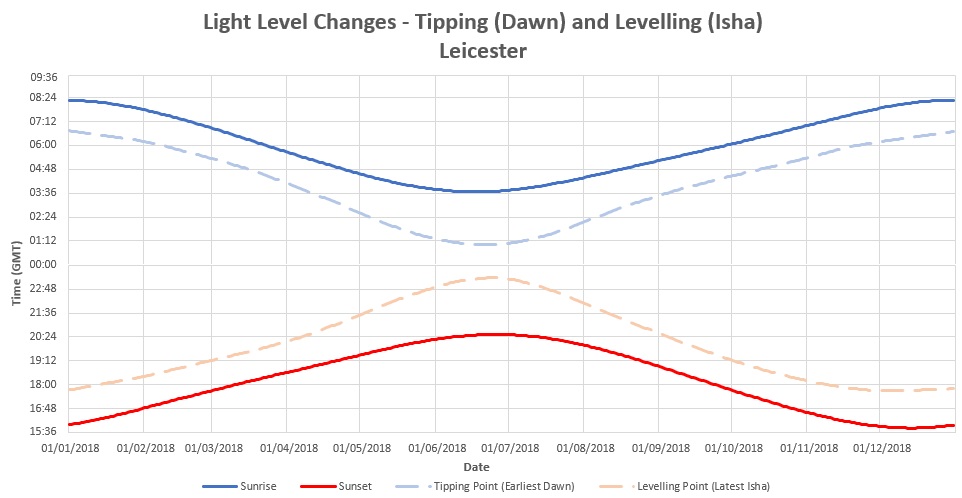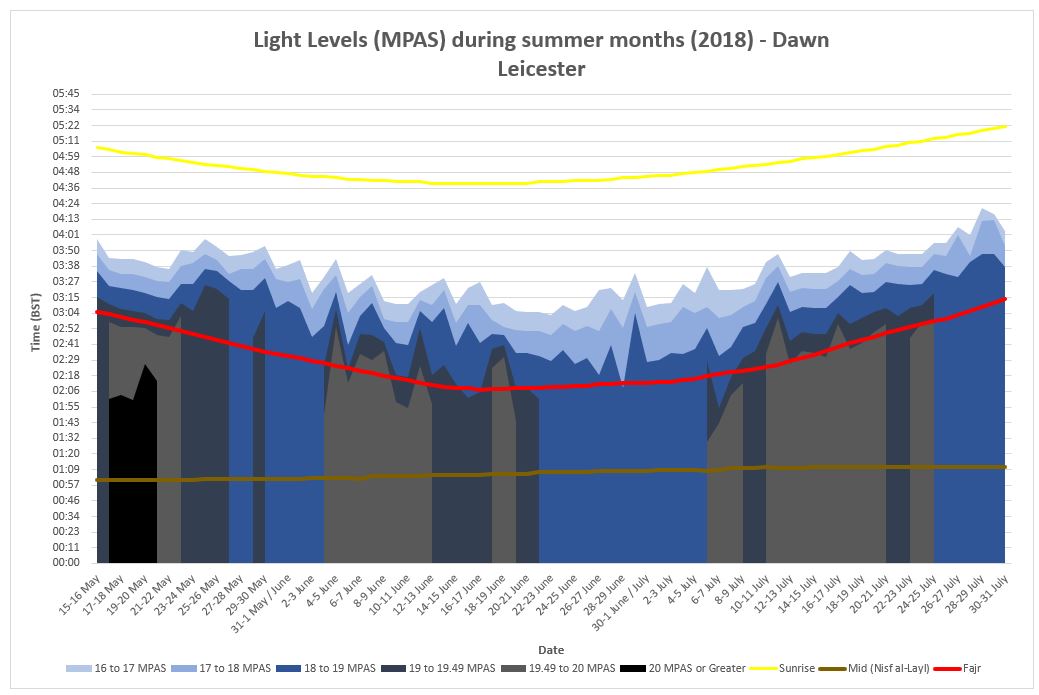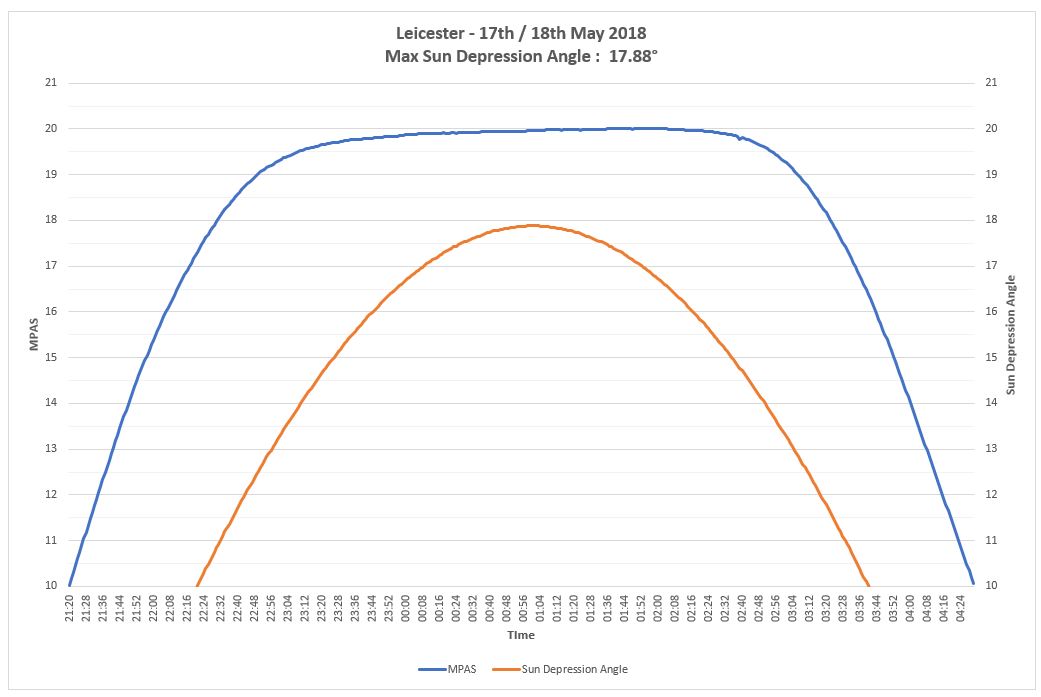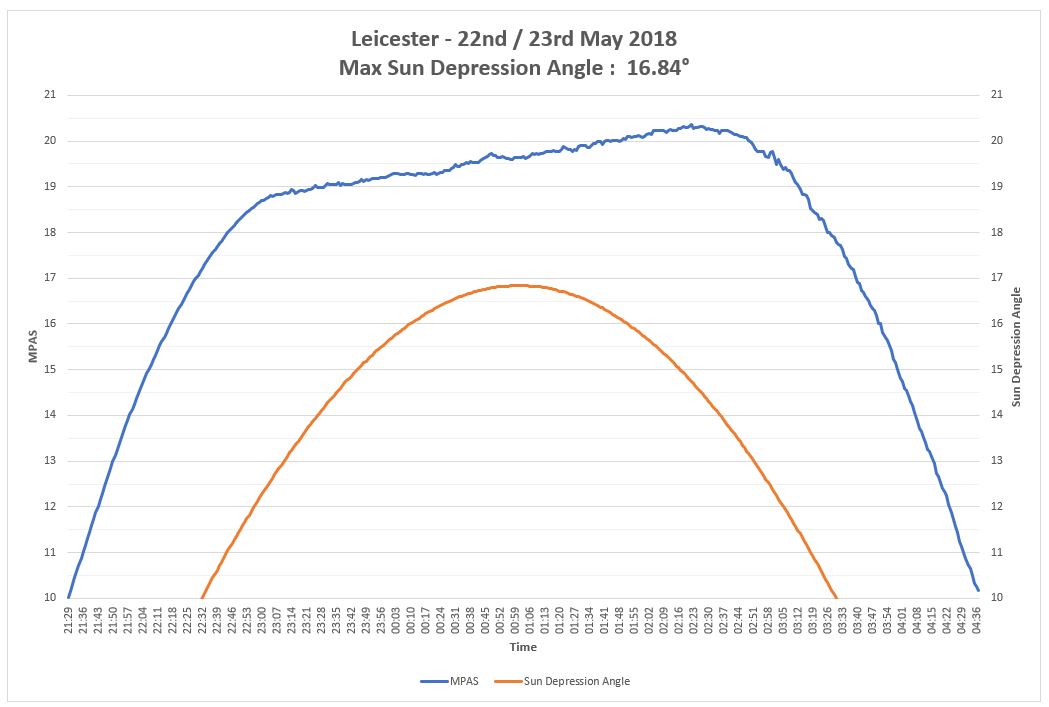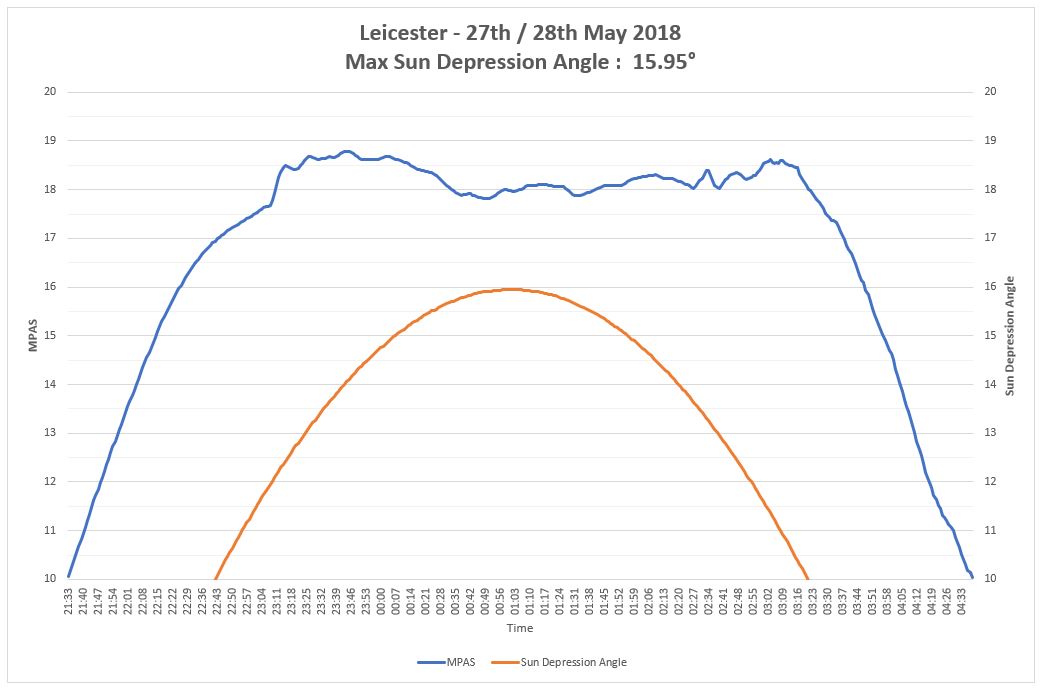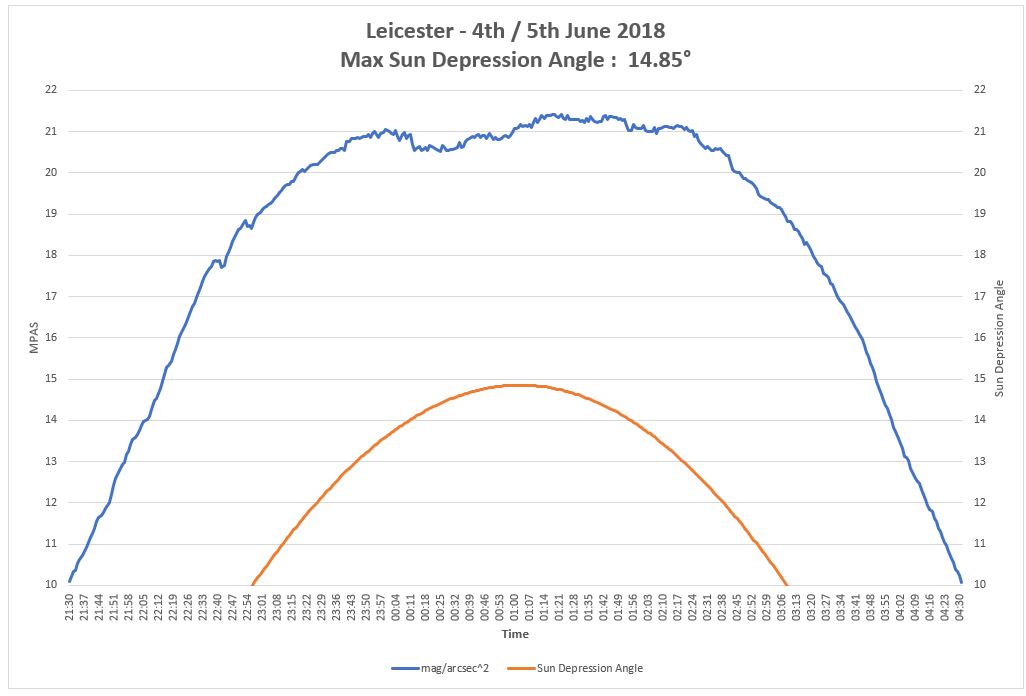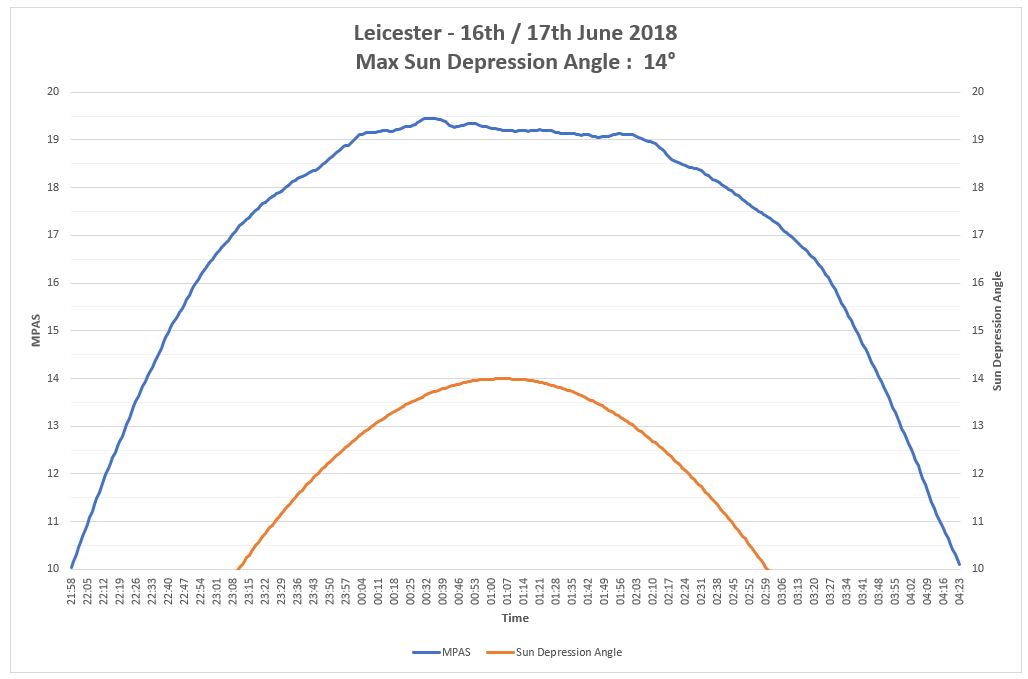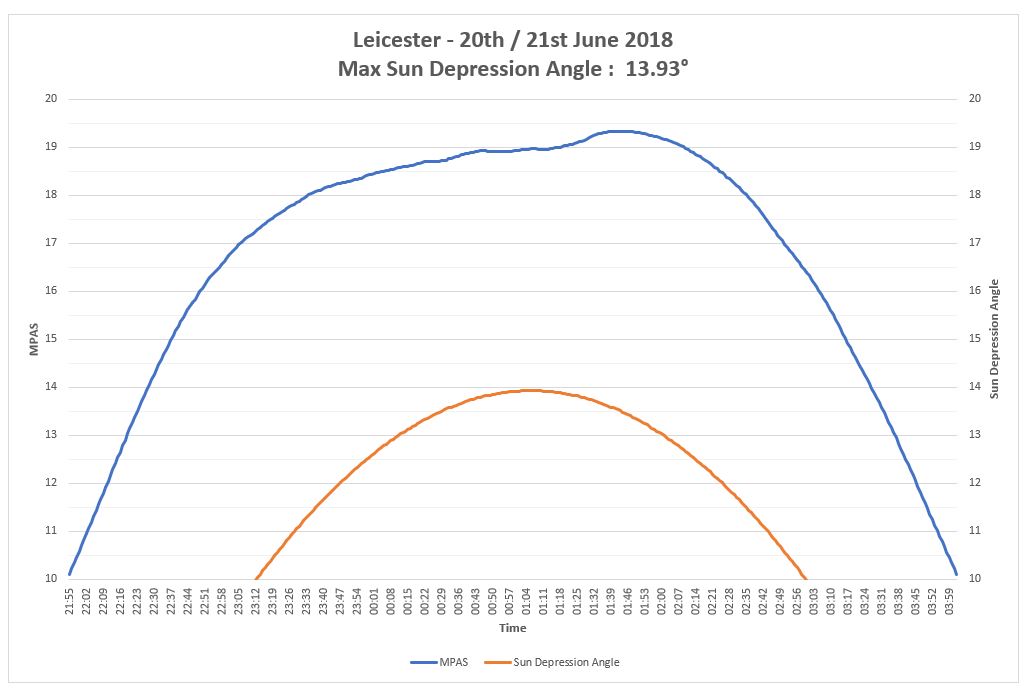At extreme latitudes the twilight may persist between sunset and the next sunrise for certain months of the year. In these months the Sun does not go below the horizon by an amount sufficient to extinguish twilight. Hence there is no true night. On the summer solstice in Leicester the Sun only sets to the depression angle of 13.93°. This is a scientific principle and a function of the depression angle you wish to use. For example, if you choose to use 18° then for 72 day of the year in Leicester during the summer you have persistent twilight. If you choose to use 13° you have zero days.
Even when you compare the extreme ends of the spectrum; the levelling point (Levelling Point for Isha) and tipping point (Tipping Point for Dawn) there is no cross-over (persistent twilight) between the two calculated LOWESS curves. The graph below shows the period between sunset and sunrise the following morning for a complete year with the calculated levelling and tipping points. At its latest possible point, Shafaq al-Abyad (Isha) starts at 23:22 GMT (00:22 BST) with Subh al-Sadiq (dawn) at 1:00 GMT (2:00 BST) leaving a period of 98 minutes where twilight does not exist.
[Click Image to Expand]
During the summer months in the UK, when due to the depression angle used (e.g. 18°) , there becomes a requirement to use an Islamic alternative such as Nisf al-Layl (middle night).
Nisf al-Layl is zero azimuth when the sun transits from west to east. As seen from the chart below, for the non middle lunar days then sky continues to remain dark after Nisf al-Layl (Orange Line).
Mid-May for Leicester is the point at which the depression angle of the sun does not reach 18° and yet the darkness remains at an MPAS reading of 20 or greater (black area on chart).
It is much later that twilight begins to change (grey into dark blue) and the point at which this project has established dawn to be occuring.
If there was persistent twilight in the UK, you would expect the light levels to change much closer to Nisf al-Layl (Orange line on the chart).
[Click Image to Expand]
The Sky Quality Meter (SQM) presented us with the ability to 'measure' light changes to see if twilight was truly persisting during the height of the summer months.
The continuous data logging of light level readings (magnitudes per square arcsecond - MPAS) from sunset to sunrise the following morning, was charted against the depression angle of the sun to see if ambient light remained. In relation to the measurement of MPAS to determine the existence of persistent twilight you would expect the following:
- The MPAS level to remain low in the absence of moonlight or any other light source (twilight remains).
- The MPAS after sunset does not eventually level off but curves through the middle of the night and then curves back down toward dawn
- There is a strong correlation between azimuth / depression angle of the sun as its transits and the resulting light levels (MPAS)
If the commonly held belief that persistent twilight does occur when the sun stops reaching the depression angle of 18°, then for Leicester between 17th May and 27th July you could expect the SQM to give results similar to the attributes described above.
The following charts show the MPAS reading from just after sunset to just before sunrise the following morning during this period. The charts also show the depression angle of the sun.
[Click Image to Expand]
At the first day where the sun does not reach the depression angle of 18°, the chart shows the clear flat period during the night between 23:31 BST and 2:35 BST where MPAS stays at a high darkness level of 20. If persistent twilight was occurring then you would a closer correlation between the altitude of the sun and corresponding changes in twilight.
[Click Image to Expand]
At the point where the sun does not reach the depression angle of 17°, there begins to be more of a curve to the MPAS reading but it still reaches a high MPAS level of above 19. The MPAS levels off at 23:41 BST and increases as the moon sets. The tipping point is 2:28 BST where the MPAS has reached the very dark level of 20.3 MPAS.
[Click Image to Expand]
At the point where the sun does not reach the depression angle of 16°, there is more of a curve to the MPAS reading and does not reach 19 MPAS due to the full moon. There as 'bulge' in the MPAS both before and after the maximum depression angle of 15.95°. The MPAS does not start to decrease after zero azimuth but starts to tip at 2:34 BST with a levelling point 23:46 BST the night before. There is clearly a period where the sun below the horizon is not resulting in (persisting) twilight.
[Click Image to Expand]
At the point where the sun does not reach the depression angle of 15°, there is more of a curve to the MPAS reading which has a correlation with the depression path of the sun. The MPAS reaches a very dark level of 21 which is maintained between the leveling point of 23:44 BST and 2:18 BST. There is clearly a period where the sun below the horizon is not resulting in (persisting) twilight.
[Click Image to Expand]
At the point where the sun reaches the depression angle of 14°, there is more of a curve to the MPAS reading which has a correlation with the depression path of the sun. MPAS does reach 19 from 00:05 BST and begins to tip at 2:03 BST. Despite the transit of the sun the MPAS remains relatively flat at its peak.
[Click Image to Expand]
At the summer solstice the sun only reaches a depression angle of 13.93°. There is more of a curve to the MPAS reading which has a correlation with the depression path of the sun but MPAS levels off before azimuth (1:06 BST) at 00:46 BST and tips back at 1:50 BST.
What the light level analysis shows in respect to persistent twilight:
- Measurable and persistent twilight can not be detected using the SQM at the point where the sun does not reach the depression angle of 18°.
- It is after 15° when you begin to see curving of the MPAS reading as the sun transits from west to east but still has a high (dark) MPAS reading.
- Even 14° there is a 'flatness' at the peak suggesting there is no influence on twilight from the sun as it transits from west to east.
- It is only very close to the summer solstice that you see a strong relationship between MPAS reading and the transit of the sun
- From the data collected, Subh al-Sadiq (dawn) can be established for the vast majority of the year in the UK and so no alternative method is required.
- There is no cross-over between the extreme positions of the levelling point (latest Isha) and the tipping point (earliest dawn)
- Light level readings show now real changes at or just after Nisf al-Layl indicating persistent twilight is not an issue for England and Wales

